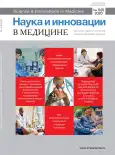Indicators of humoral regulation of the circulatory system in obese patients
- Authors: Zaletova T.S.1, Derbeneva S.A.1, Feofanova T.B.1, Katsuba A.A.1
-
Affiliations:
- Federal research center of nutrition, biotechnology and food safety
- Issue: Vol 5, No 2 (2020)
- Pages: 88-92
- Section: Cardiology
- URL: https://journal-vniispk.ru/2500-1388/article/view/43796
- DOI: https://doi.org/10.35693/2500-1388-2020-5-2-88-92
- ID: 43796
Cite item
Full Text
Abstract
Objectives – to study the indicators of humoral regulation of circulatory system in obese patients as the predictors of CHF development.
Materials and methods. Two groups of 40 patients were formed: the first group consisted of patients with I or II grades obesity with BMI of up to 40 kg/m2, the second group included patients with grade III obesity with BMI of over 40 kg/m2. None of the selected patients had a history of cardiovascular events. The concentration value of renin-angiotensin-aldosterone system components and level of N-terminal pro B-type natriuretic peptide (NT-pro-BNP) was determined.
Results. Aldosterone level in grade I–II obese patients was close to normal upper border: 58.9 [54.9; 73.8] pg/ml (normal range is 10–60 pg/ml), while in patients with grade III obesity it was 79.5 [64.5; 90.1], which is 25.9% higher than in patients of the first group and 24.5% higher above the normal level (p < 0.05). These two groups was significantly different not only in average plasma aldosterone level, but in absolute number of patients with hyperaldosteronism, whose number accounted for 46.2% in grades I or II obese patients and 85.7% among patients with grade III obesity. Plasma renin level and angiotensin II levels in both groups was within the normal range. NT-proBNP level in the first group was 23.7 [10.6; 23.6] pg/ml, in the second group – 138.0 [121.5; 145.9] pg/ml, which is 5.8 times higher (p = 0.001). In both groups of patients, the correlation analysis showed that aldosterone and NT-proBNP levels are closely related (r = 0.74, p < 0.05).
Conclusion. This study suggests that aldosterone level can be used as a predictor of HF.
Full Text
##article.viewOnOriginalSite##About the authors
Tatyana S. Zaletova
Federal research center of nutrition, biotechnology and food safety
Author for correspondence.
Email: Tatyana.zaletova@ya.ru
ORCID iD: 0000-0002-3492-1778
researcher, Department of Personalized therapy and dietetics
Russian Federation, MoscowSvetlana A. Derbeneva
Federal research center of nutrition, biotechnology and food safety
Email: Tatyana.zaletova@ya.ru
ORCID iD: 0000-0003-1876-1230
PhD, Senior researcher, Department of Cardiovascular pathology
Russian Federation, MoscowTatyana B. Feofanova
Federal research center of nutrition, biotechnology and food safety
Email: Tatyana.zaletova@ya.ru
ORCID iD: 0000-0002-6271-7037
PhD, researcher, Department of Personalized therapy and dietetics
Russian Federation, MoscowAndrei A. Katsuba
Federal research center of nutrition, biotechnology and food safety
Email: Tatyana.zaletova@ya.ru
ORCID iD: 0000-0002-4616-1825
resident of the Department of Cardiovascular pathology
Russian Federation, MoscowReferences
- Arutyunov GP. Therapy of heart failure. Is the choice of the first drug always determined? Russkiy meditsinskiy zhurnal. 2006;2:137–142. (In Russ.). [Арутюнов Г.П. Терапия ХСН. Всегда ли детерминирован выбор первого препарата? Русский медицинский журнал. 2006;2:137–142].
- Vogt B, Bochud M, Burnier M. The association of aldosterone with obesity-related hypertension and the metabolic syndrome. Seminars in nephrology. 2007;27(5):529–537. doi: 10.1016/j.semnephrol.2007.07.009
- Lastra G, Habibi J, Whaley-Connell A, et al. Direct renin inhibition improves systemic insulin resistance and skeletal muscle glucose transport in a transgenic rodent model of tissue renin overexpression. Endocrinology. 2009;150(6):2561–2568. doi: 10.1210/en.2008-1391
- Pulakat L, DeMarco V, Ardhanari S, et al. Adaptive mechanisms to compensate for overnutrition-induced cardiovascular abnormalities. American journal of physiology-regulatory, integrative and comparative physiology. 2011;301(4):885–895. doi: 10.1152/ajpregu.00316.2011
- Tasic I, Lovic D. Hypertension and cardiometabolic disease. Front Biosci (Schol Ed). 2018;1(10):166–174.
- Chen B, Chen X, Liu C, et al. Huang Y Co-expression of Akt1 and Wnt11 promotes the proliferation and cardiac differentiation of mesenchymal stem cells and attenuates hypoxia/reoxygenation-induced cardiomyocyte apoptosis. Biomed Pharmacother. 2018;108:508–514. doi: 10.1016/j.biopha.2018.09.047
- Steinbusch L, Luiken J, Vlasblom R, et al. Absence of fatty acid transporter CD36 protects against Western-type diet-related cardiac dysfunction following pressure overload in mice. American journal of physiology-endocrinology and metabolism. 2011;301(4):618–627. doi: 10.1152/ajpendo.00106.2011
- Zhou X, Ma L, Habibi J, et al. Nebivolol improves diastolic dysfunction and myocardial remodeling through reductions in oxidative stress in the zucker obese rat. Hypertension. 2010;55(4):880–888. doi: 10.1161/hypertensionaha.109.145136
- Malhotra J, Kaufman R. ER Stress and Its Functional Link to Mitochondria: Role in Cell Survival and Death. Cold Spring Harbor Perspectives in Biology. 2011;3(9):004424. doi: 10.1101/cshperspect.a004424
- Chakrabarti A, Chen A, Varner J. A review of the mammalian unfolded protein response. Biotechnology and Bioengineering. 2011;108(12):2777–2793. doi: 10.1002/bit.23282
- Donald F, Behan SHC. Obesity and overweight fact sheet N°311. WHO-2012. Available at: http://www.who.int/mediacentre/factsheets/fs311/en. Accessed 19.02.2020
- Alpert M. Obesity cardiomyopathy: pathophysiology and evolution of the clinical syndrome. The American journal of the medical sciences. 2001;321(4);225–236. doi: 10.1097/00000441-200104000-00003
- Dudenbostel T, Ghazi L, Liu M, et al. Body mass index predicts 24-hour urinary aldosterone levels in patients with resistant hypertension. Hypertension. 2016;68(4):995–1003. doi: 10.1161/hypertensionaha.116.07806








